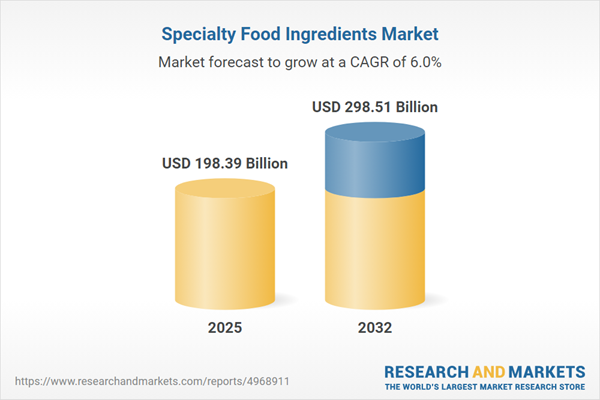Speak directly to the analyst to clarify any post sales queries you may have.
The specialty food ingredients market is undergoing dynamic shifts as manufacturers and suppliers respond to new regulatory, technological, and consumer-driven demands. This comprehensive report provides senior decision-makers with a clear, actionable overview of current and emerging market trends to inform strategic planning and execution.
Market Snapshot: Specialty Food Ingredients Market Analysis
The Specialty Food Ingredients Market grew from USD 187.11 billion in 2024 to USD 198.39 billion in 2025. It is expected to continue growing at a CAGR of 6.01%, reaching USD 298.51 billion by 2032. Substantial development in clean-label product innovation, enhanced consumer awareness of health and wellness, and advancing food processing technologies are collectively driving change in this sector. Producers and suppliers are focusing on novel ingredient functionalities and navigating an evolving global regulatory landscape, cementing the role of speciality ingredients in product differentiation and supply chain strategy.
Scope & Segmentation
This report offers a detailed segmentation of the specialty food ingredients landscape, reflecting both the diversity and complexity of the market.
- Product Types: Acidulants (acetic, citric, lactic acids), Antioxidants (natural, synthetic forms), Colorants (natural, synthetic), Emulsifiers (lecithin, mono and diglycerides, sorbitan esters), Enzymes (amylases, lipases, proteases), Flavors (artificial, natural), Preservatives (chemical, natural), Stabilizers (gums, hydrocolloids), Sweeteners (artificial, natural).
- Applications: Bakery, Beverages (alcoholic, non-alcoholic), Confectionery (candy, chocolate), Dairy (butter, cheese, yogurt), Meat and Poultry, Sauces and Dressings, Snacks.
- Forms: Gel, Granular, Liquid, Powder.
- Sources: Bio-based, Natural, Synthetic.
- Functions: Antioxidant, Colorant, Emulsifier, Enzyme, Flavor Enhancer, Preservative, Stabilizer, Sweetener.
- Regions: Americas (North America, Latin America), Europe Middle East & Africa (Europe, Middle East, Africa), Asia-Pacific.
- Key Companies: Agropur Cooperative, Amano Enzyme Inc., AMCO Proteins, AMINOLA BV, Archer Daniels Midland Company, Ashland Inc., Axiom Foods, Inc., Biocatalysts Limited, Cargill, Inc., Chr Hansen Holding A/S, Crespel & Deiters GmbH & Co KG, Evonik Industries AG, FDL Limited, Givaudan SA, Ingredion Incorporated, International Flavors & Fragrances Inc., Kerry Group PLC, Omega Protein Corporation, Royal DSM NV.
Key Takeaways for Decision-Makers
- Technological advancements such as encapsulation, fermentation, and high-pressure processing are unlocking new ingredient functionalities, supporting cleaner labels and tailored nutritional profiles.
- Regulatory complexity has increased, particularly around sustainability mandates, traceability, and transparent labeling. Decision-makers must proactively adapt compliance measures to remain competitive in regulated markets.
- Regional strategies are increasingly vital, with Asia-Pacific showing significant momentum in demand for convenience and premium nutrition, while EMEA prioritizes sustainability and traceability.
- Leading industry participants are pursuing targeted acquisitions, joint ventures, and R&D investments to expand capabilities and accelerate the commercialization of novel ingredients, especially for plant-based and functional products.
- Digital transformation and supply chain digitization are enhancing real-time visibility, predictive analytics, and resilience against market disruptions.
- Integration of operational sustainability, from sourcing bio-based inputs to deploying renewable energy, is becoming essential for industry leadership and long-term growth.
Tariff Impact on Supply Chains and Procurement
The 2025 adjustments to United States tariff schedules are increasing pressure on raw material costs, especially for key specialty food ingredients. Companies are mitigating risks by diversifying sourcing to regional suppliers, emphasizing localization, and adopting tariff engineering strategies. These market shifts are driving organizations to reassess procurement methods and enhance supply chain resilience through adaptive frameworks and scenario modeling.
Methodology & Data Sources
Research findings draw on extensive secondary and primary sources, including industry reports, regulatory databases, and interviews with suppliers and regulatory experts. Quantitative data were triangulated and validated through expert panels, ensuring statistical reliability and actionable insights for the specialty food ingredients market.
Why This Report Matters
- Empowers business leaders to navigate evolving consumer demands and regulatory complexities with actionable market intelligence.
- Supports risk mitigation by offering guidance on sourcing strategies and the impact of international trade fluctuations.
- Enables organizations to inform product development and portfolio diversification with up-to-date segmentation and regional analysis.
Conclusion
This report equips senior stakeholders with strategic insights to navigate a rapidly evolving specialty food ingredients market. By leveraging advances in technology, regulatory awareness, and collaborative innovation, businesses can seize growth opportunities and build resilience for the future.
Additional Product Information:
- Purchase of this report includes 1 year online access with quarterly updates.
- This report can be updated on request. Please contact our Customer Experience team using the Ask a Question widget on our website.
Table of Contents
3. Executive Summary
4. Market Overview
7. Cumulative Impact of Artificial Intelligence 2025
Companies Mentioned
The companies profiled in this Specialty Food Ingredients market report include:- Agropur Cooperative
- Amano Enzyme Inc.
- AMCO Proteins
- AMINOLA BV
- Archer Daniels Midland Company
- Ashland Inc.
- Axiom Foods, Inc.
- Biocatalysts Limited
- Cargill, Inc.
- Chr Hansen Holding A/S
- Crespel & Deiters GmbH & Co KG
- Evonik Industries AG
- FDL Limited
- Givaudan SA
- Ingredion Incorporated
- International Flavors & Fragrances Inc.
- Kerry Group PLC
- Omega Protein Corporation
- Royal DSM NV
Table Information
| Report Attribute | Details |
|---|---|
| No. of Pages | 187 |
| Published | November 2025 |
| Forecast Period | 2025 - 2032 |
| Estimated Market Value ( USD | $ 198.39 Billion |
| Forecasted Market Value ( USD | $ 298.51 Billion |
| Compound Annual Growth Rate | 6.0% |
| Regions Covered | Global |
| No. of Companies Mentioned | 20 |









